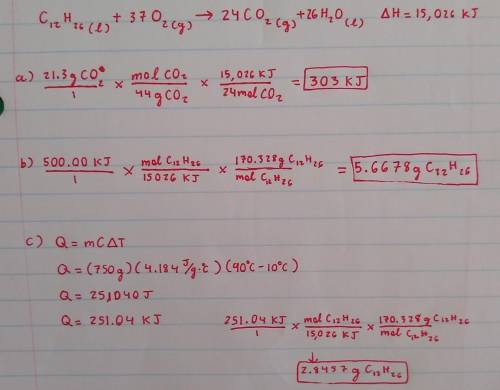
Chemistry, 10.08.2021 07:10, yourmumsanoodle
1. Consider the following thermochemical reaction for kerosene:
2 C12H26(l) + 37 O2(g) 24 CO2(g) + 26 H2O(l) + 15,026 kJ
(a) When 21.3 g of CO2 are made, how much heat is released?
(b) If 500.00 kJ of heat are released by the reaction, how grams of C12H26 must have been consumed ?
(c) If this reaction were being used to generate heat, how many grams of C12H26 would have to be reacted to generate
enough heat to raise the temperature of 750g of liquid water from 10oC to 90oC?
2. Consider the reaction: NaNO3(s) + H2SO4(l) → NaHSO4(s) + HNO3(g) ΔH° = 21.2 kJ
How much heat must absorbed by the reaction system to convert 100g of NaNO3 into NaHSO4(s)?
3. What is the enthalpy change when 49.4 mL of 0.430 M sulfuric acid reacts with 23.3 mL of 0.309 M potassium
hydroxide?
3.
H2SO4(aq) + 2KOH(aq) → K2SO4(aq) + 2H2O(l) ΔH° = –111.6 kJ/mol

Answers: 3
Other questions on the subject: Chemistry

Chemistry, 21.06.2019 20:30, babygirl2984
There is an area in idaho named craters of the moon where most of the ground is covered with basalt, adark gray, igneous rock with no visibl crystals. what can you infer about the geographical history of the area?
Answers: 1

Chemistry, 21.06.2019 22:30, granthazenp5e9mj
Which feature do highland climates have that lower elevation areas do not?
Answers: 1


Do you know the correct answer?
1. Consider the following thermochemical reaction for kerosene:
2 C12H26(l) + 37 O2(g) 24 CO2(g)...
Questions in other subjects:



Mathematics, 06.10.2021 04:00




History, 06.10.2021 04:00

Physics, 06.10.2021 04:00

Mathematics, 06.10.2021 04:00








